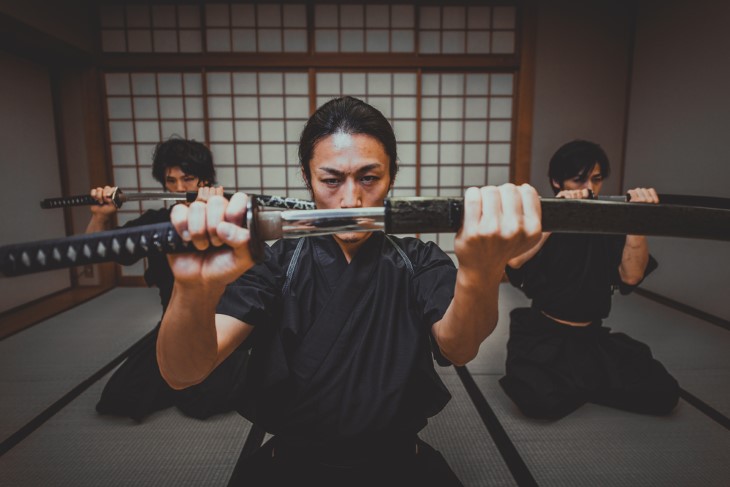
When we think of ninjas, our minds often conjure images of black-clad assassins, stealthily moving through the night, performing impossible acrobatics, and wielding exotic weapons. These portrayals, popularized by movies, comic books, and video games, are thrilling but far from accurate. The true history of the ninja is much richer and more complex, rooted in the tumultuous history of feudal Japan. Let’s take a journey through time, exploring the origins, evolution, and enduring legacy of these enigmatic figures.
The Origins: From Farmers to Fighters
The earliest mentions of ninjas, or shinobi as they were originally known, date back to the Heian period (794-1185). Unlike the samurai, who were bound by a strict code of honor and served noble lords, ninjas were often recruited from the peasantry. These were men and women who needed to protect their families and lands from the constant threats of war and banditry.
In the mountainous regions of Iga and Kōga, present-day Mie and Shiga prefectures, these early ninjas began to develop their unique skills. They were not warriors by birth but became so out of necessity. They mastered the art of guerrilla warfare, learning to use the terrain to their advantage, creating traps, and perfecting the use of simple farming tools as weapons. This practical approach to combat set the foundation for what would later be known as ninjutsu.

The Iga and Kōga regions were particularly suited for fostering the development of ninjutsu due to their geographic isolation and rugged landscapes. These areas were difficult to conquer, making them ideal for small groups of guerrilla fighters. The local population, largely made up of farmers, had to rely on their wits and intimate knowledge of the environment to survive. Over time, these farmers honed their skills in stealth, disguise, and surprise attacks, which became the hallmarks of ninja tactics.
Ninjas of this era were not only fighters but also skilled in espionage. They gathered intelligence, spread misinformation, and engaged in psychological warfare. This multifaceted approach to conflict allowed them to operate effectively even when outnumbered or outgunned. Their ability to adapt and innovate was crucial in a period marked by constant upheaval and warfare.
The social structure of early ninja communities was relatively egalitarian compared to the rigid hierarchies of samurai society. While samurai adhered to the bushido code, which emphasized loyalty, honor, and martial prowess, ninjas were pragmatic and flexible. Their primary goal was survival, and they used any means necessary to achieve it. This included forming alliances with local warlords, engaging in trade, and even practicing agriculture when not engaged in conflict.
Training in ninjutsu was rigorous and began at a young age. Children were taught to move silently, blend into their surroundings, and use their environment to their advantage. They learned to climb, swim, and hide in plain sight. Weapons training focused on practical tools that could be easily concealed or disguised, such as the kunai (a multipurpose tool that could be used as a knife, shovel, or climbing aid) and the tessen (a war fan that could be used for defense or as a blunt weapon).
The Rise of the Ninja: Feudal Japan's Secret Agents
The Kamakura period (1185-1333) saw the rise of the samurai class, and with them, the need for espionage and unconventional warfare grew. Ninjas were not just mercenaries; they became invaluable as spies, scouts, and saboteurs. Their knowledge of the land, ability to move undetected, and skills in disguise made them perfect for these roles.
During the Kamakura period, the political landscape of Japan was fragmented, with numerous feudal lords vying for power. This environment created a demand for covert operations that could provide strategic advantages without engaging in open warfare. Ninjas, with their skills in stealth and deception, were perfectly suited to meet this demand. They were employed by various factions to gather intelligence on enemy movements, infiltrate rival territories, and conduct sabotage missions.

The Sengoku period (1467-1603), a time of near-constant civil war, was the golden age of the ninja. Daimyos (feudal lords) across Japan employed ninjas to gather intelligence, conduct raids, and assassinate rivals. The most famous of these were the Iga and Kōga clans, who became legendary for their effectiveness and secrecy.
The Sengoku period was characterized by intense and frequent conflicts as regional lords fought for dominance. The chaotic nature of this era provided ample opportunities for ninjas to demonstrate their value. They were employed not only for their combat skills but also for their ability to manipulate and influence events from the shadows. Ninjas could infiltrate enemy castles, steal valuable information, and even turn the tide of battles through strategic sabotage.
One of the most significant roles of ninjas during this period was intelligence gathering. They operated as undercover agents, blending into local populations and collecting crucial information on enemy plans and movements. This intelligence allowed daimyos to make informed decisions and gain strategic advantages. Ninjas also engaged in counterintelligence, identifying and neutralizing enemy spies.
Ninjas' skills in sabotage were equally important. They could disrupt supply lines, poison water sources, and set fire to enemy encampments. These actions weakened enemy forces and created confusion and distrust within their ranks. Assassination was another critical aspect of ninja operations. They could eliminate key figures, such as rival leaders or military commanders, creating power vacuums and destabilizing enemy factions.
The Iga and Kōga clans became renowned for their expertise in ninjutsu during the Sengoku period. Their reputation for secrecy and effectiveness made them highly sought after by daimyos across Japan. These clans operated as independent mercenaries, offering their services to the highest bidder. Their knowledge and techniques were closely guarded secrets, passed down through generations within the clans.
Despite their fearsome reputation, ninjas were often more than just warriors. They were also skilled in various arts and sciences, including medicine, herbalism, and psychology. Their understanding of human nature and ability to manipulate emotions and perceptions were crucial to their success. This holistic approach to warfare made them versatile and adaptable, capable of handling a wide range of missions.

As the Sengoku period drew to a close and Japan began to unify under the Tokugawa shogunate, the role of the ninja began to change. The need for covert operations diminished, and many ninjas returned to their lives as farmers or integrated into other aspects of society. However, their legacy continued to influence Japanese culture and military strategy for centuries to come.
By understanding the true origins and rise of the ninja, we can appreciate the complexities of their history and the skills that made them legendary. Far from the one-dimensional portrayals in popular media, ninjas were multifaceted individuals whose contributions to Japanese history were both profound and enduring.
Contrary to popular belief, ninjas did not typically wear all-black outfits. In fact, they dressed to blend in with their surroundings. During the day, this could mean wearing the clothes of a peasant, merchant, or monk. At night, darker clothing helped them move through the shadows, but it was often navy blue or dark brown, not black.
Their weaponry was equally pragmatic. While movies glorify shuriken (throwing stars) and katana (swords), ninjas primarily used whatever was at hand. They favored tools that could be easily disguised or explained away if captured. This included the kunai (a multipurpose tool), caltrops (small spiked objects scattered to slow pursuers), and even everyday items like sickles and chains.
One of the most misunderstood aspects of ninjas is their supposed magical abilities. Stories of invisibility, walking on water, and shape-shifting are entertaining but entirely fictional. These myths likely stem from the ninjas' exceptional skills in stealth and deception. They used misdirection, psychological warfare, and a deep understanding of human nature to achieve their goals. For example, they might spread rumors to sow discord or use disguises to gather intelligence.
The unification of Japan under the Tokugawa shogunate (1603-1868) marked the beginning of the end for the ninja. With the country at peace, the need for their services diminished. Many ninjas returned to their lives as farmers or integrated into other aspects of society. Some even became security advisors to the shogunate, using their skills to maintain order rather than disrupt it.
The Tokugawa shogunate ushered in an era of relative peace and stability known as the Edo period. With the unification of Japan, the widespread conflicts and power struggles that had necessitated the services of ninjas dwindled significantly. As the country settled into this newfound stability, the clandestine skills of the ninja were no longer in high demand. However, the legacy of their expertise did not disappear overnight. Many ninjas, unable to abandon their lifelong training, found new roles in this transformed society.
Some ninjas took on roles as security advisors to the shogunate. They utilized their knowledge of espionage, strategy, and martial arts to help maintain order and prevent uprisings. Their deep understanding of psychological warfare and surveillance made them valuable assets in this new capacity. These former shadow warriors now worked to protect the stability they once thrived on disrupting.
Others returned to agrarian life, blending back into the rural communities from which many of them had originally come. They brought with them a wealth of knowledge that could be applied to agriculture and village defense. The skills they had honed in stealth, navigation, and improvisation proved useful in various aspects of daily life. Despite their reintegration into civilian life, the aura of their past remained, shrouding them in a mystique that intrigued their fellow villagers.
Despite their decline, the mystique of the ninja continued to grow. During the Edo period (1603-1868), ninjas became the subject of popular fiction and theater. Their exploits were romanticized and exaggerated, laying the groundwork for the myths that persist today.
Kabuki theater, a popular form of dramatic performance, began to feature ninjas in its plays. These characters, often portrayed as cunning and almost supernatural beings, captured the imagination of audiences. The portrayal of ninjas in kabuki was far from historical accuracy, emphasizing dramatic flair over factual representation. They were shown performing incredible feats of agility, disappearing in puffs of smoke, and outwitting powerful foes. These exaggerated depictions cemented the image of the ninja as an almost mythical figure.
The Meiji Restoration (1868-1912) brought about significant social and political changes in Japan, further distancing the country from its feudal past. The samurai class was abolished, and with it, the remnants of the ninja's historical role faded into obscurity. However, the fascination with ninjas did not wane. Instead, it evolved, finding new expressions in modern media.
In the 20th century, ninjas experienced a resurgence in popular culture, particularly in the West. From the silent but deadly warriors in early Japanese films to the colorful heroes in comic books and cartoons, the image of the ninja evolved into a global phenomenon. This version of the ninja, though largely fictional, drew on the historical figure's enduring legacy of ingenuity, adaptability, and resourcefulness.
Movies, television, and later video games introduced the ninja to an international audience, solidifying their place in popular culture. The allure of the ninja's secretive and skilled nature resonated with audiences worldwide. Characters like the Teenage Mutant Ninja Turtles and popular video game protagonists brought the ninja into the modern era, blending historical elements with contemporary storytelling.

Today, ninjutsu is practiced as a martial art, with schools around the world teaching techniques that have been passed down through generations. While the emphasis is often on physical skills, true ninjutsu also incorporates mental discipline and strategy, staying true to its roots in survival and warfare. Modern practitioners honor the legacy of the ninja by studying the historical techniques and philosophies that made them legendary.
Despite the embellishments and myths that have surrounded the ninja over the centuries, their true history remains a testament to their ingenuity and adaptability. The decline of the ninja in the face of a unified Japan did not erase their impact; instead, it transformed them from real-life shadow warriors into enduring legends of popular culture.
To truly appreciate the history of the ninja, we must look beyond the sensationalized stories and recognize the reality of their existence. Ninjas were not supernatural beings but highly skilled individuals who used their wits and training to survive in a dangerous and unpredictable world. They were masters of adaptability, capable of turning the simplest tools into deadly weapons and using the natural environment to their advantage.
The ninja's story is one of resilience and ingenuity. It reminds us that history is often more fascinating than fiction and that the true legacy of the ninja lies not in their myths but in their real-world contributions to the art of warfare and survival.
As we reflect on the true history of the ninja, we gain a deeper appreciation for these shadow warriors. They were not the black-clad assassins of Hollywood fame, but rather, they were ordinary people who rose to extraordinary challenges, leaving an indelible mark on the history of Japan and the world.
In conclusion, the ninja's tale is a testament to human resourcefulness and the enduring power of legend. While the myths will continue to capture our imagination, it is the true story of the ninja that deserves our respect and admiration.